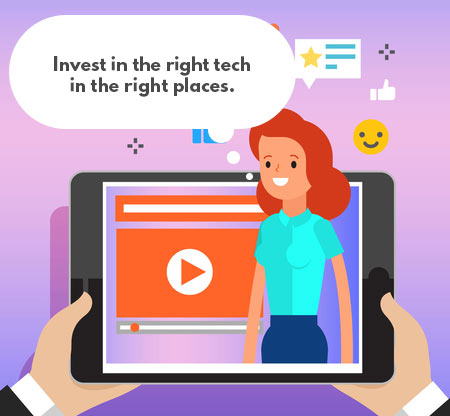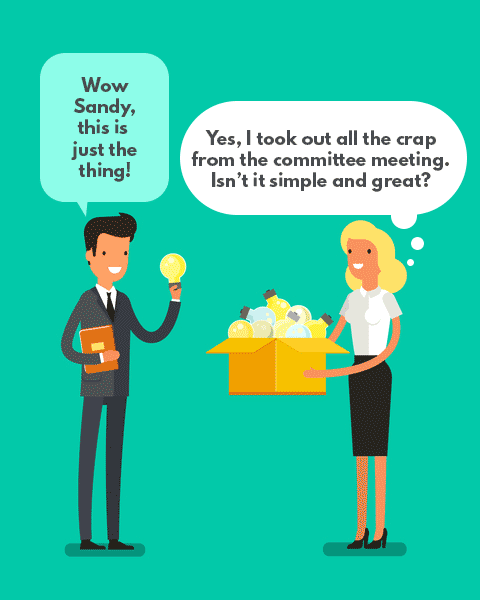As a new business owner there is always a mountain of work to be done, and often times every decision is going to you directly. How do you choose wisely and avoid pitfalls if you’ve never done it before? Today I’ll tell you a couple of secrets that I’ve learned over the years so that you can completely skip over some of the traps and quicksand that awaits.
These are all seriously juicy bites of business acumen that experience will teach you, whether you want them to or not. So get ahead of the bus, and don’t let it hit you! I want you to have every advantage and go in strong. Here are five things that will change your life and your business if you apply them.
A Laser Focused Sense of Business Perspective
 Bias. Whatever your background and experiences, they lead you to have your own unique biases and subconscious patterns. Sometimes this can totally derail your business, your budget, and timelines if you don’t recognize it immediately and rein it in. This is problematic and if you’ve ever seen an entrepreneur “chasing their tail” over something that wasn’t critical, you know it is a vicious cycle. This might look like the design company who is endlessly tweaking their design (and can’t launch), the email marketing campaign that never gets off the ground because its owner can’t stop revising it, and the startup who runs out of runway (aka dollars) because they can’t stop going back to square one as the leader has epiphanies. Yikes.
Bias. Whatever your background and experiences, they lead you to have your own unique biases and subconscious patterns. Sometimes this can totally derail your business, your budget, and timelines if you don’t recognize it immediately and rein it in. This is problematic and if you’ve ever seen an entrepreneur “chasing their tail” over something that wasn’t critical, you know it is a vicious cycle. This might look like the design company who is endlessly tweaking their design (and can’t launch), the email marketing campaign that never gets off the ground because its owner can’t stop revising it, and the startup who runs out of runway (aka dollars) because they can’t stop going back to square one as the leader has epiphanies. Yikes.
Start Project Managing Effectively
What you really want to do is create a skeleton for the entire process, and step through the “limbs” to flesh them out one by one. Make the key decisions early on, and everything else will be filling in the details. Too often I see folks trying to skip out on the foundation laying part of the project (you can see all the steps to a successful web project here) and ending up totally exasperated at their team and their custom website agency. Whose fault was it really? If you are serious about leadership (and I myself am make-or-break serious) then you will know that the leader always takes the hit. So the question really becomes, who was leading the project? More often than not, you will find that the project management on these failed endeavours was weak, and there was little or no project skeleton on which to build.
Fix The Perfectionism You Are Biased Towards
If you find yourself ever saying one of these, do a quick business perspective check-in and make sure you are on the right side of the fence:
- The _______ (UI, message, layout, cta, etc) has to be perfect.
- Reality Check: It needs to be really good, but rarely is the time and effort justified to chase perfection.
- What about _____ (small niche use case, minority of users, etc)? Things won’t be perfect for these users.
- Reality Check: Do not chase outliers to your business model endlessly. This includes the 1/1000 customer, the hypothetical circumstance customer that no one has ever met, and IE6 users. Your time is too valuable to use this way.
- But will it appeal to ______ (blind au pairs in Michigan, stay at home cheesemakers, underwater basket weavers)?
- Reality Check: If you are hunting deer, don’t get stuck tracking a mouse.
Your time and resources are finite. There are always going to be things to pick apart over even the most seemingly perfect of launches. Point a professional hater at any target, and they will find something to nitpick. At some point you will always need to decide what is good enough and abandon perfection.
The big takeaway: Don’t major on minors!
Appropriately Estimate Your Technologies
 Though I have been building websites since before all of the mobile browsers we have now, the excuse to avoid mobile got ever harder to justify as smartphones entered (and eventually halved) the web browsing market. While we used to have a handful of desktop screen sizes to pinpoint (800×600 anyone?) that ship has long sailed and now the way forward is through responsive design, where a website looks respectable at just about any configuration you throw at it. I had to evolve!
Though I have been building websites since before all of the mobile browsers we have now, the excuse to avoid mobile got ever harder to justify as smartphones entered (and eventually halved) the web browsing market. While we used to have a handful of desktop screen sizes to pinpoint (800×600 anyone?) that ship has long sailed and now the way forward is through responsive design, where a website looks respectable at just about any configuration you throw at it. I had to evolve!
Why does this matter? Well, you have to be open to new things but also have an appropriate process to gauge what things are going to be important. Look at how fast the tech market moves: even the iPod has almost gone the way of the minidisc player, as users simply switch to smartphones for the same function. So many of us are taking pictures with our phones as well instead of carting around a separate camera, and these are not even the tip of the iceberg of web development tech trends.
Which Tech Trends Matter?
Just like how fashion comes and goes, there are so many buzzwords and titles out there that savvy entrepreneurs want you to get on board with. Which ones are important though, and which ones can you safely ignore or table for later? You will have to make choices even if you don’t want to do the heavy reading.
It’s so easy for a custom website builder (or any business really) to fluff up their service list and make it look like the world is going to be delivered on a platter. When in doubt, ask.
Some of these things really will be important! There will be key service tie-ins (like to your favorite CRM for example), responsive or mobile first design, seo ready content, and accessibility features – these are very legitimate. There will be many others that would be helpful but alas, they do not apply to your actual business. You will need to mentally weed them out. If you find later down the line that something you paused on has really taken off (like I did with responsive design and mobile), you can get back on the horse at any time.
Consider at each juncture the value that each technology is going to bring to your organization. Do not let your budget get squeezed for things that don’t add real value to your customer base.
Pay Attention to Psychographics
 This one is so huge and also such a departure from the marketing meetings of old. At first it will seem a little scary to cut huge swathes of folks out of your marketing endeavours in one fell swoop, but once you see the benefits there will be no turning back.
This one is so huge and also such a departure from the marketing meetings of old. At first it will seem a little scary to cut huge swathes of folks out of your marketing endeavours in one fell swoop, but once you see the benefits there will be no turning back.
I’ve written before about how if you speak to everyone, you speak to no one. It’s like a bowl of Cream of Wheat, bland and recognizable as food but nobody really wants it. Prove me wrong right now, go order a bowl of plain Cream of Wheat at your favorite restaurant, and completely ignore the rest of the menu! Now write to me and tell me how much you enjoyed it. Mmmm, blandiness.
But Are We Not Ignoring Lots of Potential Customers?
The thing is, you won’t be completely cutting out those other people from your message. But you will be tailoring your message to match exactly with a much smaller, more carefully selected crowd. It is better to be the saving grace for ten people than to hard-sell and deliver to fifteen people who aren’t even excited to receive what they bought from you. Guess which crowd is going to give you more good press, repeat business, and referrals. But how did you find those people?
Marketing After Demographics
The answer is psychographics, also sometimes called avatar marketing. Instead of targeting a group defined by their physical characteristics and geography — which we used to do as standard practice — like “housewives in their 60’s who like rap music in South Dakota”, you make your criteria based more on mental state and motivations. So start targeting “the forever young who still want to stick it to the establishment in the midwest”. Do you see the critical difference there?
A Different Approach to Marketing
Focus on behavior and what drives it, and use that as your platform to serve. Think about Pinterest and why it is so successful. If you really think it’s because all humans like pretty pictures, guess again. I’d venture to say that a key demographic to the Pinterest service is secretly (probably even to themselves) motivated to be a Super Mom, to have it all in life, and keep up with the Joneses. This is just one of many profiles, but you can bet it is the one that keeps some women (who I know in real life) pinning recipes and home decorating tips on a daily basis so that they may curate their home life and get a gold star on their forehead. Chances are good that if you are reading this, you are not one of those people. You may have a Pinterest account (heck even I signed up for one recently) but if you are starting a business, you won’t have time to master Ten Ways to Prepare Elegant Hotdogs for The Fourth of July.
Everyone has a Psychographic, Multiple Even
You and I are changemakers, not neighborhood domestic goddesses. And guess what? There are so many companies who know this and market right to us. So you do the same! Identify 2-6 of your very best customer types, and focus on what they really want out of life. Is it a legacy in their community, an unbreakable circle of friends, an incredible sense of family, or to build a successful business empire?
We all want a lot of the same things in life. But if you say just the right words, I’ll turn my head and listen intently to what you have to say.
MVP: How Business Fortunes Are Made
 This MVP stands for Minimum Viable Product, and it is also your most valuable player. We’re touching back a little on point #1 here (a sense of perspective), and also building on years of successful business practices written down in thick memoirs.
This MVP stands for Minimum Viable Product, and it is also your most valuable player. We’re touching back a little on point #1 here (a sense of perspective), and also building on years of successful business practices written down in thick memoirs.
Do you know what a lot of successful CEOs recount about their early days in business? They talk about what incredible results they got for their customers and the companies they built, all while knowing that there product wasn’t perfect. Some products were downright flimsy or terrible, and they only got patched up and fixed as time went on. You’ll hear this one a lot for software products, where the initial release was heavy on the graphics and user experience, and the underlying code was “cautiously optimistic” at best — later to be patched with updates so long as sales rolled in.
Don’t Mistake a Lean Initial Offering for Shoddiness
I’m not saying that you should build some claptrap and sell it off to customers as the golden fleece. Not in the slightest. What we’re talking about here though is Minimum Viable Product, and it’s becoming a staple in the startup world. Ask yourself, what is the slimmest set of features that could get this business off the ground?
In the early stages you need to get the business up and running and start generating some revenue, right? So if you can figure out what the essential pieces of the mousetrap are, and delay the rest, you can get your ideas to market and start the wheels of progress turning. Then once the business itself is viable and has some traction, you put your R&D team back to work for the next phase of improvements.
This Makes Your Business Launches Easier
This used to be a lot harder when software was sold on discs and the internet wasn’t readily available for updates, but those days are long gone. If your product is delivered through a website, then you are perfectly set up to take advantage of Continuous Integration, which is a way to build and deploy software updates on a micro scale. Many of your favorite websites are using CI to introduce new features (and fix bugs) on an almost daily basis. Etsy is famous for their Continuous Integration. Most other giants are doing this as well.
When you see the product development process as a long string of improvements over time, it frees you up to get started faster and really identify the essentials of your product. Physical product lines have been doing this for a long time. Have you ever bought a blender or a food processor? It comes with a couple of things right out of the box, and so many more attachments are available as a second purchase. The company didn’t have to come to market with everything ready to go in one box. They just needed the blender (here I go again waxing on poetically about blenders) and everything else followed in time.
Get a New Way of Thinking: Websites As Evolving Creatures
My clients are quickly encouraged to get into the mindset of “initial build, second build” on all website projects. This alleviates so many headaches as well, when new ideas come up in the middle of the project and need to be slotted somewhere. The answer is always, Lets stick with our MVP and begin the second phase (next version) right after launch. This way they are never held back from launch. It is so important to get out there and capitalize on time in the market. There are also big SEO gains to be made over the weeks until the second phase build is ready to go.
First get Barbie, then later you can get the Malibu dream house and all her friends. Minimum Viable Product for the win.
You Need to Believe In Your Idea & Business
This last one is so important and I’m ending on it so that you can marry it with all the ideas we’ve discussed above. You need to believe strongly in your idea, and use this enthusiasm/firm resolve mixture to steer the ship. No one else can be as excited about this venture as you can. Well, except investors if you’ve promised them the moon and the stars. But you know what I’m talking about here, you will be the unshakeable pillar of the whole enterprise, so you better feel it!
Case Study: She Didn’t Go For It
Just recently I consulted with a woman with a new startup idea, and I was delighted with her enthusiasm and preparedness for the venture. She had the resources, education, and opportunity for this business. She had already invested real time and dollars into fleshing out and legally protecting her ideas. When I followed up with her two weeks later, I was surprised and dismayed to find that after all the time and effort she had invested into the venture, she had made the choice not to pursue it any longer.
Why not? Well ultimately (and in hindsight), she did not truly believe in her idea. She laid the ground work and met with prospective professionals (myself included), getting estimates and direction. In the end though, the green lights clearly did not appear for her, because she chose not to continue. This is what happens when there is a lack of belief in your idea and yourself, and possibly an insurmountable level of fear.
The Truth About Fear for Business Owners
Who said entrepreneurs don’t get afraid? Of course they do! If anything, they are trying to become adept at squashing all our normal human fears on a minute-by-minutes basis. We won’t get into the Playing It Safe lecture today, but I trust you know where that would lead if we did get into it.
To meet someone who had the right marketing direction, a solid service model, the time, the money, and the groundwork laid who then dropped it all, this was a wakeup call for me. Had I been a career salesperson, I could have told this person that “everything would be okay” and “you just stick with me and I’ll lead you to the promised land.” This is what was missing from the equation all along, an iron-clad promise of success on the other side. This client wanted to be told in no uncertain terms that it would all work out, and probably that it would also chug along with very little effort on her part once it was going.
Where Safety Really Originates
While I completely understand the Playing It Safe mindset, you have to understand as an entrepreneur that YOU are the security in your business. If you aren’t a quitter, then the game isn’t over. To get the reward you have to take the leap. It’s going to involve betting on yourself and everything that drives you. And if you go back and read those same CEO memoirs, you’ll find that there will be failures on the road, and it’s what you do next that matters. You must keep steering the ship.
Remember, you must be the unshakeable core of your business.
Lauren Grey is a website building machine (well, not literally) with a little bit of sass and a lot of enthusiasm for her clients and their results. She offers free consultations by phone and email, click here to request one and give a URL if you already have a site up and running.
Ms Grey has a penchant for working with women entrepreneurs and furthering the presence of women in tech. If you need custom website services and want serious intelligence behind it, she’s your gal. Services for every budget, $1,500 – $30,000 – just ask.
Last updated on
